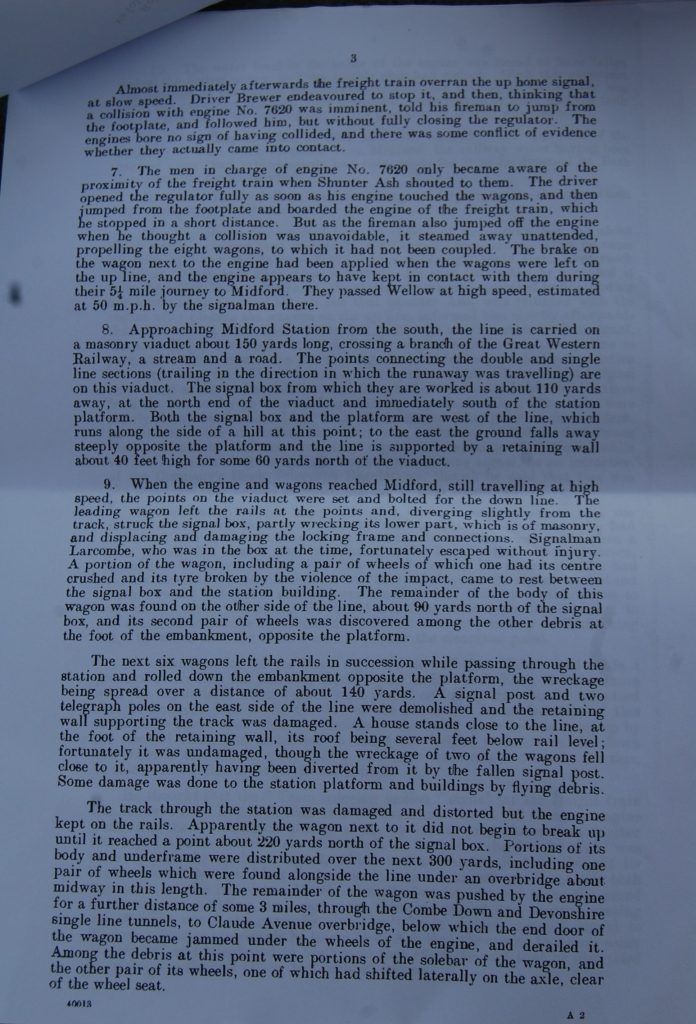Claude Avenue
- 2023-02-10
- Trackback URL
- Uncategorised
This is a Ministry of Transport report on the crash that took place on the Somerset and Dorset coal railway in 1936. It’s missing the last few pages but is still a fascinating historical document. I’ve OCRed the first page below.








Ministry of Transport, 7, Whitehall Gardens, London, S.W.1. 8th December, 1936.
I have the honour to report for the information of the Minister of Transport, in accordance with the Order of 4th August, 1936, the result of my Inquiry into the accident which occurred between Radstock and Bath, on the Somerset and Dorset Joint Railway, at about 10.0 a.m. on 29th July. During shunting operations at Braysdown signal box, near Radstock, an engine ran away on the right line towards Bath, with neither driver nor fireman on the footplate; it was propelling eight empty wagons. The line becomes single track at Midford, some 5-i miles nearer Bath. The wagons left the rails there, 7 wrecking the signal box and doing considerable damage in the vicinity of the station. The greater part of the debris was thrown clear of the track, but the engine remained on the line and ran on towards Bath, pushing a portion of one of the wagons. After passing through two single line tunnels it was derailed under a bridge, some 3 miles further on, on the outskirts of Bath. While the runaway was approaching, shunting was in progress at a private siding on the single line, between Midford and the point where the final derailment took place; fortunately the work there was finished shortly before its arrival, and the engine concerned had returned to Bath. There were no personal injuries in this series of accidents; the weather at the time was fine and clear.
Description. of the Line.
2. The line runs northwards from Radstock to Bath, a distance of about ten miles; north is also the up direction. On this section of the line there are signal boxes at Braysdown, at Wellow Station, and at Midford Station, respec-tively about 1, 3/, and 61 miles from Radstock; the line is double between Radstock and Midford, and single thence to Bath Junction, where it joins the L.M.S. line from Mangotsfield to Bath. Approaching Radstock from the south, the line crosses the Mendip Hills, rising steeply for about eight miles, mainly at 1 in 50, from Evercreech Junction to the summit between Masbury and Binegar, and then falling for about 7i miles at 1 in 60 and 1 in 50 to Radstock. North of Radstock the line first rises at 1 in 100 and 1 in 330 for i-mile, and then falls at 1 in 120 for i-mile to Brays-down signal box. Thereafter it is undulating, and gradually falling, for the 51 miles to Midford, which is approached down a gradient of 1 in 60 about i-mile in length. North of Midford it rises sharply, at 1 in 100 and 1 in 50 for about a mile, to Combe Down Tunnel, which is just over a mile in length and mainly on a rising gradient of 1 in 100. From the northern end of this tunnel the line falls at 1 in 50 and 1 in 66 for two miles to Bath Junction; Devonshire Tunnel, }-mile long, is situated on this section. The final derailment took place beneath Claude Avenue Bridge, about I-mile beyond the north end of Devon-shire Tunnel and about the same distance south of Bath Junction. There is much curvature over the whole length of the line between Radstock and Bath.
3. At Braysdown signal box, which is on the east side of the line, there are two trailing crossovers between the running lines, that to the north of the box being worked by lever No. 14 and that to the south of it by lever No. 6. There are also sidings on both sides of the line. Those on the west serve Braysdown Colliery and have a trailing connection (No. 5 lever) in the up line, while those on the east, serving Writhlington Colliery, have a trailing connection (No. 7 lever) in the down line.